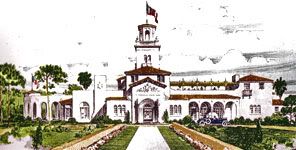
The Mysterious Disappearance of D.P. Davis
Part II of a series
The Bloom comes off the Florida Boom
By Geoff Dobson
Off the west coast of Africa lie the Cape Verde Islands. In August and September, tropical waves develop over the savannahs of Africa and drift westward over the warm waters of the Atlantic. South of the Islands, the tropical waves may develop into disturbances which, as they move westward, develop into hurricanes. With the great distances over the warm waters, they are the most severe of the hurricanes, and from their birthplace take the name of Cape Verde hurricanes.
The infamous Galveston Hurricane of 1900 and the Long Island Hurricane of 1938 were both Cape Verde storms. Advance warnings of hurricanes prior to satellites and radar were dependent upon wireless signals sent by ships at sea or cables sent from distant islands over which the storms might pass.
In early September 1926, reports of a disturbance in the eastern Atlantic began to filter into the Weather Bureau in Washington. On September 14, the wireless operator on the Bermuda and West Indies Steamship, Ltd. steamer S. S. Matura, bound for New York from Dominica, sent a signal that the ship was in a disturbance 200 miles north of St. Kitts. On the same day, its sister ship, the S.S. Mayaro 300 miles west of Bermuda, bound for New York from Grenada, signaled that it was in the eye of a different hurricane.
On St. Kitts that morning, there were gentle breezes which by that evening had increased to force 5. Thus, warnings were cabled to the Turks. By September 16 conditions on Turks Island began to worsen. At 8:00 a.m. the barometer began to fall. By 10:20 a.m., the winds had picked up to 36 m.p.h. with a heavy sea swell. At 1:00 p.m., a signal was sent to the weather bureau that winds were estimated at over 100 m.p.h. Fifty-five minutes later the weather observer fled his office when it lost its roof and the water was above the window sills. No further weather signals were received from Turks Island until October 7.
During the spring and summer of 1926, the real estate feeding frenzy that was the Florida Boom began to cool. In Tampa, a disturbing trend began. Many of the lots on Davis Island had been sold with the D. P. Davis organization taking back mortgages. The rates of defaults soared. In Broward County, the British-American Improvement Association had been organized to sell some 2,000 lots. The Association descended into bankruptcy.
Officers of the Arcadia Gardens Project in Arcadia were indicted on a charge of mail fraud relating to its real estate promotion. Officials in other states warned against investment in Florida real estate.
Nevertheless, David Paul Davis, the developer of Davis Island and St. Augustine’s Davis Shores was confident. To augment other policies, Davis took out a new $300,000.00 life insurance policy with Sumter Lowry’s newly formed Liberty Life Insurance Company in Tampa (now Gulf Life). The insurance was additional security for a $250,000.00 loan Davis took out to support his St. Augustine development. [Lowry, himself was born in St. Augustine in August 1893 as a hurricane passed to the east.] Davis’ fleet of motor coaches continued bringing buyers to the miracle being developed on the northern end of Anastasia Island.
In Sarasota, circus magnate John Ringling had commenced a project similar to Davis Shores in St. Augustine. The Ringling Isles project was located on the off-shore islands of St. Armands Key and Longboat Key, and was connected to the mainland by a causeway and bridge. Ringling had proposed that his development would be the site of the winter White House to be occupied by President Harding.
Unfortunately, President Harding had the temerity to die when returning from a visit to Alaska before final arrangements could be made for a new presidential retreat.
On the southern end of Longboat Key was to be located a 200 room hotel with golf course. The exterior of a massive pink hotel was nearing completion in 1926 when Ringling recognized the bloom was off the boom and discontinued construction. The hotel sat abandoned surrounded by jungle which grew up on the site of the golf course.
The only visitors were occasional teenagers exploring the vacant partially completed building. Ultimately, with higher real estate values and potential liability as an attractive nuisance, the hotel was razed in the 1970’s. One of the writer’s high school classmates was killed exploring the structure when he fell down an unguarded elevator shaft.
South Florida was still optimistic. September 16 was another typical gorgeous Florida day. Blue skies greeted Miami. On September 17, the newly formed University of Miami opened for classes with 560 students. The talk of the day was whether the Cardinals or the Reds would represent the National League and whether the Yankees or the Indians would represent the American League in the upcoming World Series.
That evening, in Ft. Lauderdale, the Jewish community met in the roof top garden of a local restaurant in observance of Yom Kippur. The scudding clouds above caused little concern. That morning, the Miami Herald reported that the storm would miss Florida.
Nevertheless, the National Weather Bureau had some concern and at 10:02 a.m. cabled the British governor of the Bahamas, Sir Harry Edward Spiller Cordeaux requesting that “special observations” be sent every two hours. Undoubtedly, Sir Harry had problems of his own. At 1:00, p.m. a wireless signal was sent from Nassau. The capital was then being buffeted by force 9 winds. No further reports from Nassau were received in Miami.
Finally, at thirty-five minutes to midnight, the hurricane warning flags were hoisted above the Federal Building in downtown Miami. Approximately an hour and half later, telephone communication to Miami Beach and Hollywood was lost. By 3:00 a.m. telephones within the City were lost. Electric lights at the Federal Building went out an hour later. Instruments were read with a borrowed flashlight. When the eye of storm came, residents of Miami Beach attempted to flee across the causeway. Many were drowned when their motor cars were washed into Biscayne Bay when the eye wall of the great storm returned.
The Miami hurricane was the final blow to the Florida Boom. Steam yachts of the land barons ended up in the streets of Miami. Four hundred were dead, more than 6,000 were injured, and 50,000 were left homeless. Miami lost half its population.
(Ed: After everything was lost, Lester and Sarah Bernstein fled Miami in 1926, surviving the hurricane and moving to St. Augustine to “start over” — establishing a retail store in the building of Sarah’s parent’s, the Tarlinksy’s on St. George Street, that was originally called “The Junior Shop” and later known as JR Department Store, now JR Uniform Company)
The hurricane did not directly impact Tampa or St. Augustine. Thus, the development of Davis Shores continued. The motor buses continued to bring sales prospects. Construction advanced.
Next Week: D. P. Davis sails for Europe — and disappears.
Geoff Dobson, a St Augustine resident for the past 32 years, is a western and Florida history writer. He is a former president of the St. Augustine Historical Society and a regular contributor of nostalgic memories to Historic City News. Before his parents moved to Florida, his father was a Black Angus cattleman. Geoff has written extensively on Wyoming history (“Wyoming Tales and Trails”). When Geoff was in high school, his family lived in the cattle country of eastern Sarasota County. The family spread, which his parents called “Wild Cat Slough,” was reachable only by a pair of ruts over the sand hills and through a snake and gator infested slough. Now, it is an area of four-lane roads, expensive subdivisions, shopping centers, and office parks. . His undergraduate degree is in history. Geoff received his post-graduate degree from the University of Florida. He may be reached at horse.creek.cowboy@gmail.com
